Identification of promoter motifs involved in the network of phytochrome A-regulated gene expression by combined analysis of genomic sequence and microarray data
- PMID: 14681527
- PMCID: PMC300717
- DOI: 10.1104/pp.103.030437
Identification of promoter motifs involved in the network of phytochrome A-regulated gene expression by combined analysis of genomic sequence and microarray data
Abstract
Several hundred Arabidopsis genes, transcriptionally regulated by phytochrome A (phyA), were previously identified using an oligonucleotide microarray. We have now identified, in silico, conserved sequence motifs in the promoters of these genes by comparing the promoter sequences to those of all the genes present on the microarray from which they were sampled. This was done using a Perl script (called Sift) that identifies over-represented motifs using an enumerative approach. The utility of Sift was verified by analysis of circadian-regulated promoters known to contain a biologically significant motif. Several elements were then identified in phyA-responsive promoters by their over-representation. Five previously undescribed motifs were detected in the promoters of phyA-induced genes. Four novel motifs were found in phyA-repressed promoters, plus a motif that strongly resembles the DE1 element. The G-box, CACGTG, was a prominent hit in both induced and repressed phyA-responsive promoters. Intriguingly, two distinct flanking consensus sequences were observed adjacent to the G-box core sequence: one predominating in phyA-induced promoters, the other in phyA-repressed promoters. Such different conserved flanking nucleotides around the core motif in these two sets of promoters may indicate that different members of the same family of DNA-binding proteins mediate phyA induction and repression. An increased abundance of G-box sequences was observed in the most rapidly phyA-responsive genes and in the promoters of phyA-regulated transcription factors, indicating that G-box-binding transcription factors are upstream components in a transcriptional cascade that mediates phyA-regulated development.
Figures
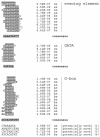
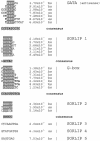

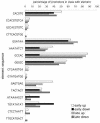
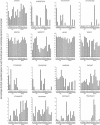
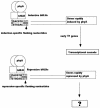
Similar articles
-
The phytochrome-interacting factor PIF7 negatively regulates DREB1 expression under circadian control in Arabidopsis.Plant Physiol. 2009 Dec;151(4):2046-57. doi: 10.1104/pp.109.147033. Epub 2009 Oct 16. Plant Physiol. 2009. PMID: 19837816 Free PMC article.
-
The Arabidopsis phytochrome A gene has multiple transcription start sites and a promoter sequence motif homologous to the repressor element of monocot phytochrome A genes.Photochem Photobiol. 1994 Mar;59(3):379-84. doi: 10.1111/j.1751-1097.1994.tb05051.x. Photochem Photobiol. 1994. PMID: 8016219
-
Analysis of far-red light-regulated genome expression profiles of phytochrome A pathway mutants in Arabidopsis.Plant J. 2002 Dec;32(5):723-33. doi: 10.1046/j.1365-313x.2002.01462.x. Plant J. 2002. PMID: 12472688
-
Multiple transcription-factor genes are early targets of phytochrome A signaling.Proc Natl Acad Sci U S A. 2001 Jul 31;98(16):9437-42. doi: 10.1073/pnas.161300998. Proc Natl Acad Sci U S A. 2001. PMID: 11481498 Free PMC article.
-
Dissecting the phytochrome A-dependent signaling network in higher plants.Trends Plant Sci. 2003 Apr;8(4):172-8. doi: 10.1016/S1360-1385(03)00049-9. Trends Plant Sci. 2003. PMID: 12711229 Review.
Cited by
-
CALMODULIN-BINDING TRANSCRIPTION ACTIVATOR 6: A Key Regulator of Na+ Homeostasis during Germination.Plant Physiol. 2019 Jun;180(2):1101-1118. doi: 10.1104/pp.19.00119. Epub 2019 Mar 20. Plant Physiol. 2019. PMID: 30894419 Free PMC article.
-
A double SORLIP1 element is required for high light induction of ELIP genes in Arabidopsis thaliana.Plant Mol Biol. 2014 Feb;84(3):259-67. doi: 10.1007/s11103-013-0130-4. Epub 2013 Sep 27. Plant Mol Biol. 2014. PMID: 24072326 Free PMC article.
-
Global profiling of rice and poplar transcriptomes highlights key conserved circadian-controlled pathways and cis-regulatory modules.PLoS One. 2011;6(6):e16907. doi: 10.1371/journal.pone.0016907. Epub 2011 Jun 9. PLoS One. 2011. PMID: 21694767 Free PMC article.
-
Identification of Leaf Promoters for Use in Transgenic Wheat.Plants (Basel). 2018 Mar 28;7(2):27. doi: 10.3390/plants7020027. Plants (Basel). 2018. PMID: 29597282 Free PMC article.
-
Oxidative DNA damage bypass in Arabidopsis thaliana requires DNA polymerase λ and proliferating cell nuclear antigen 2.Plant Cell. 2011 Feb;23(2):806-22. doi: 10.1105/tpc.110.081455. Epub 2011 Feb 15. Plant Cell. 2011. PMID: 21325140 Free PMC article.
References
-
- Arguello-Astorga GR, Herrera-Estrella LR (1998) Evolution of light-regulated plant promoters. Annu Rev Plant Physiol Plant Mol Biol 49: 525-555 - PubMed
Publication types
MeSH terms
Substances
Grants and funding
LinkOut - more resources
Full Text Sources
Other Literature Sources
Molecular Biology Databases

